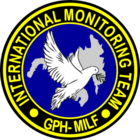International Monitoring Team
| International Monitoring Team | |
|---|---|
 | |
| Abbreviation | IMT |
| Motto | Together We Make it Happen[1] |
| Agency overview | |
| Formed | October, 2004 |
| Dissolved | June 2022 |
| Volunteers | 60 |
| Jurisdictional structure | |
| Operations jurisdiction | Philippines |
| Legal jurisdiction | Mindanao |
| Operational structure | |
| Headquarters | Cotabato City, Philippines |
| Multinational agency | Philippines |
| Nationalities of personnel |
|
The International Monitoring Team (IMT) was a monitoring team composed of 60 members headquartered in Cotabato City, Mindanao of the Philippines to monitor the implementation of peace between the Government of the Philippines (GPH) and one of the largest rebels in the region, the Moro Islamic Liberation Front (MILF) in the Moro conflict. The team is led by Malaysia,[2] followed by Brunei Darussalam,[3] Indonesia,[4] Japan,[5] Libya,[6] Norway[7] and subsequently the European Union.[8]
History[edit]
The IMT was launched in October 2004 by Malaysia together with Brunei and Libya to oversee the situation after the GPH and MILF signed their ceasefire agreement in 2003.[9] In October 2006, Japan began to join the monitoring team.[5] Armed conflict however still resumed and the security situation deteriorated until August 2008 when the national co-ordination surrounding resolutions of pending land problems failed.[5] During the period, the lead was taken by Libya which then rose skepticism from the MILF over the slowing process.[10] Malaysia then decided to withdraw its contingent in November 2008 and the IMT temporarily suspended its activities in 2009.[5] The IMT became active again in February 2010,[11] the same year when Norway began to join the monitoring team.[12] Indonesia also joined the IMT in 2011 after being invited by the Philippines in 2009.[13]
The Moro Islamic Liberation Front would sign the Comprehensive Agreement on the Bangsamoro in 2014. This in turn led to Bangsamoro autonomous region being formed in the southern Philippines in 2019 as part of the peace process. In March 2022, the Philippine government led by President Rodrigo Duterte informed that the IMT that it would no longer extend its mission. The IMT officially left the Philippines in June 2022.[14]
At its peak the IMT had 60 personnel but this figure gradually decreased over time.[14]
Order of Mission IMT[edit]
Malaysia
- Malaysian Armed Forces
- Royal Malaysia Police
- Small team of ministry by civilian personnel
•Ministry of Defence •Ministry of Foreign Affairs
Indonesia
- Indonesian Armed Forces (TNI)
- Indonesian National Police (POLRI)
Brunei
Libya (2004-2009)
- Libyan Armed Forces
Roles[edit]
IMT was responsible in monitoring the security, humanitarian, rehabilitation and development aspects, as well as socio-economic assistance and civilian protection.[2]
Areas coverage[edit]
IMT covered the areas of:[2]
- Zamboanga del Norte
- Zamboanga Sibugay
- Zamboanga del Sur
- Maguindanao
- North Cotabato
- South Cotabato
- Bukidnon
- Lanao del Norte
- Lanao del Sur
- Sultan Kudarat
- Sarangani
- Davao del Norte
- Compostela Valley
- Davao del Sur
- Davao Oriental
- Basilan
- Sulu
- Tawi-Tawi
- Palawan
Notable former IMT[edit]
Mostly malaysian military officer serve in IMT
- Major General (R) Soehaimi Abas,first leader first batch IMT and former officer high Malaysian Army
- General (R) Tan Sri Zulkifeli Mohd Zin ,former Army Chief and Chief of Defence Malaysia
- General (R) Tan Sri Zamrose Mohd Zain,former Chief of Malaysian Army
- Brigadier General Dato Radzi Abdul Hamid,veteran Second Malaysian Insurgency and writer
- Muhaiymin Wahab, civilian personnel in IMT for batch 2018 and writer Debaran Peluru di Cotabato
References[edit]
- ^ Naoyuki, Ochiai (December 2020). "Peace and Development in Mindanao, Republic of The Philippines. The Long Road to Peace Through Trust" (PDF). JICA Ogata Sadako Research Institute for Peace and Development. 1: 34. Retrieved February 4, 2022.
- ^ a b c "Terms of Reference of the International Monitoring Team (IMT)". Office of the Presidential Adviser on the Peace Process. November 21, 2016. Retrieved March 12, 2017.
- ^ "International Monitoring Team in Mindanao". Radio Televisyen Brunei. September 5, 2014. Archived from the original on April 16, 2017. Retrieved March 12, 2017.
- ^ "Tim Pengamat Indonesia dalam International Monitoring Team di Filipina Selatan" (in Indonesian). Jaringan Dokumentasi Dan Informasi Hukum, Kementerian Riset, Teknologi dan Pendidikan Tinggi. February 24, 2012. Archived from the original on March 13, 2017. Retrieved March 12, 2017.
- ^ a b c d "Resumption of Dispatch of Development Experts to the International Monitoring Team in the Philippines". Ministry of Foreign Affairs, Japan. February 26, 2010. Retrieved March 12, 2017.
- ^ "Libya Increases Participation in Mindanao Peace Process". The Tripoli Post. May 13, 2007. Archived from the original on March 12, 2017. Retrieved March 12, 2017.
- ^ "Norway supports peace process, takes active role in the decommissioning process". Royal Norwegian Embassy in Manila. February 27, 2015. Retrieved March 12, 2017.
- ^ "(Press Release) EU confirms willingness to participate in International Monitoring Team (IMT) in Mindanao" (PDF). European Union. May 18, 2010. Retrieved March 12, 2017.
- ^ Peng Er Lam (June 2, 2009). Japan's Peace-Building Diplomacy in Asia: Seeking a More Active Political Role. Routledge. pp. 80–. ISBN 978-1-134-12506-7.
- ^ "MILF skeptical over Libya lead role in IMT". GMA News. May 14, 2008. Retrieved March 12, 2017.
- ^ "Hopeful signs for end to Mindanao conflict". IRIN News. April 23, 2010. Retrieved March 12, 2017.
- ^ 张茜 (June 7, 2010). "Norway joins int'l group monitoring Mindanao peace process". Xinhua News Agency. People's Daily Online. Retrieved March 12, 2017.
- ^ "Indonesia joins the International Monitoring Team". Government of the Philippines. April 11, 2011. Retrieved March 12, 2017.
- ^ a b Maitem, Jeoffrey (July 15, 2022). "Foreign peace monitors depart southern Philippines after nearly 2 decades". Benar News. Retrieved August 14, 2022.
